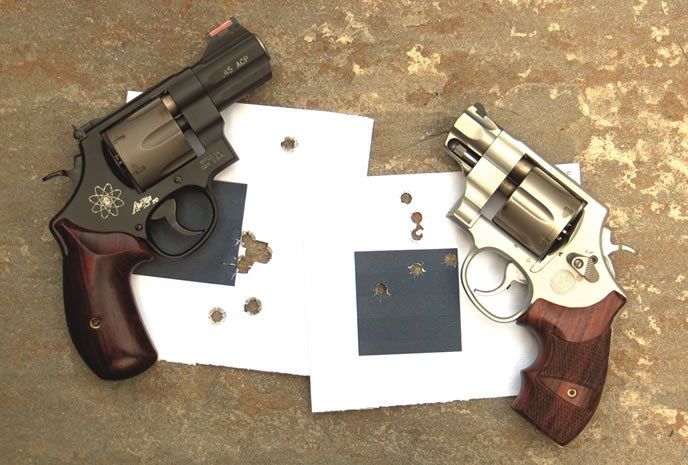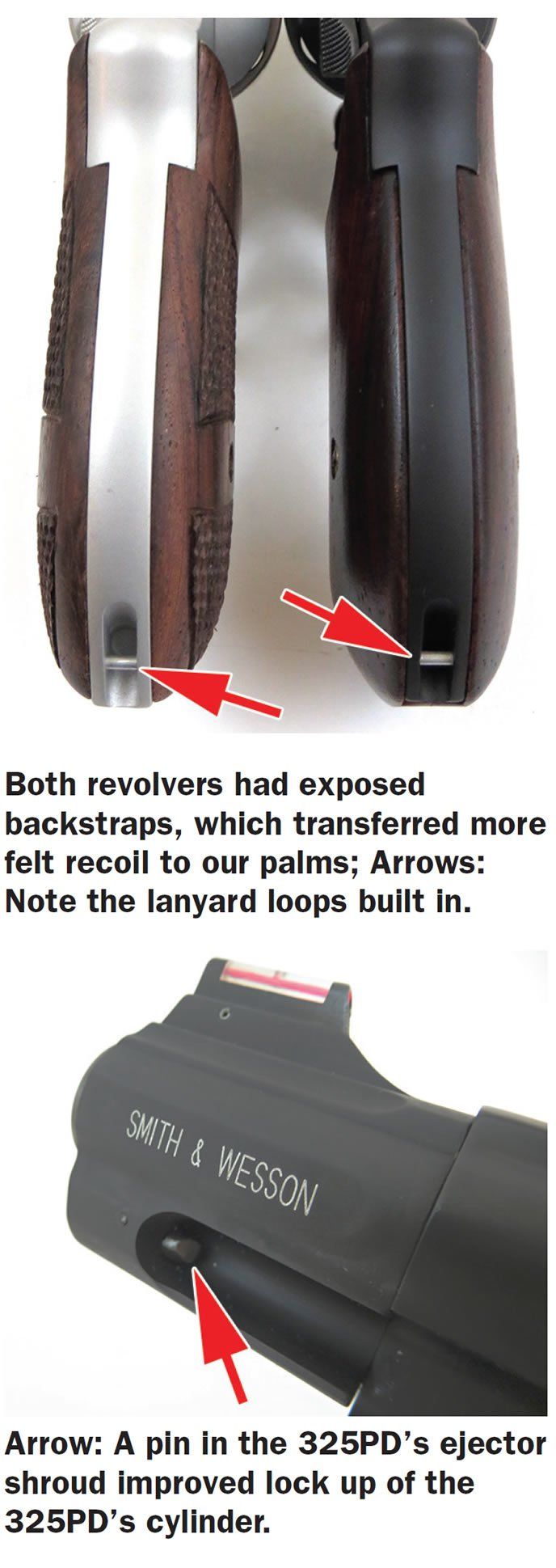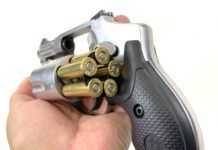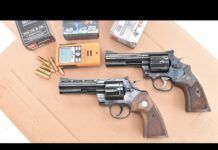Chambering 45 ACP in revolvers goes way back to the early 20th century and WWI. The U.S. military had plenty of 45 ACP ammo, but few of the then-new 1911 pistols, so the solution was to chamber Colt’s and S&W’s large-frame revolvers in the 45 ACP cartridge. Since then, numerous S&W revolvers, as well as revolvers from other manufacturers, have been chambered in 45 ACP. S&W used its large N-frame to build the Model 25, similar to a Model 29 except chambered in 45 ACP or 45 Colt, often called Long Colt to ensure it’s not confused with Automatic Colt Pistol. In fact, the Model 625 is one of the more popular action-competition revolvers. The Governor is another Smith & Wesson revolver that shoots 45 ACP. But neither of these wheelguns are compact enough for easy carry.

Compact is a relative term when describing a S&W N-frame. The N-frame is used for the S&W Model 29 chambered in 44 Magnum and high capacity 8-shot 357 Magnum revolvers like the Model 327, 627, and others. The S&W Model 325PD and the S&W Performance Center Model 625-10 tested here both feature scandium-alloy N-frames, alloy barrel shrouds, steel barrels, and titanium cylinders to cut weight, making their heft suitable for conceal carry. As a result, we found toting these wheelguns in a holster on our hip was comfortable to do, and if they performed as shooters, we would assess them as good choices for defense. Availability is something of an issue, of course, because the S&W Model 325PD is no longer produced by S&W, and the S&W Performance Center Model 625-10 was a Lew Horton Special Edition revolver offered in 2003 and 2004. But we found two that were in LNIB (Like New In Box) condition, and we saw others for sale at various retailers and auction houses in case you’re interested.

Moon clips are required to make these N-frames run fast. Clips for 45 ACP revolvers come in two-, three- and six-round clip configurations. We tested these N-frames with three- and six-round clips acquired from Numrich Gunparts Corp. (GunpartsCorp.com). Six-round moon clips (252510B) cost $1.40 each and three-round half-moon clips (252670B) cost $2.25 a pair. We also used a case-removal tool (958390B) that cost $10.65, which is a notched tube that fits over the fired case and is used to twist the empty case out of the clip.
We ran these revolvers using a mix of factory 230-grain ball ammo from Hornady and Winchester, reloads with 185-grain SWC bullets, and a load from a custom ammo reloader in 45 Auto Rim. The custom 45 Auto Rim ammo manufactured by American Custom Ammo (AmericanCustom.tripod.com, acrammo@sum.net, [850] 689-4553) was loaded with a Rainier 200-grain TMP/FN/FB bullet. The 45 Auto Rim cartridge was developed in 1920 as a substitute for 45 ACP and moon clips in M1917 revolvers. These cartridges have a thick rim and headspace on the rim.
Though both of these revolvers shared the same material in their frame construction, they were set up with different grips, barrel length, sights and lock up. Spoiler alert: The 625-10 was a real contender for conceal carry, but a defect caused it to be eliminated from consideration. Here’s more about what we found with these 45 ACP snubnose revolvers.
S&W Model 325PD 45 ACP, $700-$925
First, we tested chamber and bore alignment with a Brownells revolver range rod (080-617-045WB, Rod Combo for 45 Auto/45 Colt, $42) and found all chambers were in spec, which we had assumed because this revolver showed little signs of use. The matte-black scandium frame and barrel shroud contrasted with the gray titanium cylinder. Fit and finish were very good. The hammer, trigger, and cylinder latch were all blued steel. The hammer spur was the large, square target type with plenty of checkering to thumb back the hammer without fear of slipping. It also made the revolver a bit bulkier.
The rear sight was adjustable for windage and elevation and sported a V-notch. The rear portion of the rear sight was also serrated to eliminate glare—a detail we have come to expect from S&W. The front sight stood tall with a red fiber-optic tube that absorbed light when light was available. In dark conditions, the red tube offered some contrast, allowing shooters to pick it up quickly. The sights were very usable for defense work, as the red dot from the end of the tube seemed to naturally settle into the V-notch. The tube could be replaced with another color if desired; it was pinned in place. The top of the frame and barrel shroud were serrated nicely.
The grip was smooth wood, and our shooters found it to be hand filling. It allowed testers to get a firm hold on the revolver, especially during double-action rapid-fire testing. A lanyard loop was built into the frame of the 325PD. This feature would not be used in typical concealed-carry use, but we could see this feature being used by, say, a fly fisherman in the back country.
The 325PD had a tight lockup, and we had a confident feeling opening and closing the cylinder. We particularly liked the chamfered chambers. This allowed us to more easily chamber the fat, stubby 45 ACP cartridges. Bent clips should either be pounded flat or discarded, as we found a slightly bent clip made loading and unloading more difficult, which is something to avoid in a high-stress situation. The 325PD will also fire 45 ACP cartridges without a clip since a shoulder is machined into each chamber that allows the cartridge to headspace on the case mouth, as it does in a 45 ACP semi-automatic pistol. The issue with loading cartridges this way is, the ejector will not shuck the empty case. Each case needs to be pushed out separately with a rod, pencil, or some thin instrument that will fit into the chamber. Tedious is the best way to describe shooting the 325PD in this manner. At the range, our suspicions were confirmed. This revolver and the 625-10 transferred a lot of felt recoil into our palms. The revolver was not pleasant to shoot for an extended period of time. In single action, we were able to get about 1-inch groups from the 230-grain FMJ factory loads from Hornady and Winchester, which we thought was acceptable accuracy. The hotter handloads showed even better accuracy, with its best groups under 0.5 inches. We fired at a range of 15 yards for accuracy testing, then moved to 3, 5, and 7 yards for fast double-action shooting to simulate typical confrontation ranges. Most testers, firing as fast as they could, were able to keep six shots in center mass of the target. We also tested reloading speed by shooting a six-shot string, reloading, then shooting the fresh six rounds. We found we could, after some practice, reload the revolver almost as fast as a semi-automatic pistol. Testers liked the fact they could use the same factory ammo in the 325PD as they used in their 45 ACP semi-auto pistols. The ammo was compatible and accurate in both weapons. We also discovered that recoil with the same ammo in our 45 ACP semi-auto pistols felt much less than with the scandium-framed 325PD. We could shoot all day with a full-size full-weight 1911, P220 or G21, but not with this.
We felt the sights were tall, making the 325PD bulky for conceal carry. The front sight had a few sharp edges that could potentially snag on loose clothing during a draw. We would practice our draw from concealment with an empty gun over and over until we felt confident we could perform regardless of concealing garment.
Our Team Said: We thought the 325PD was too bulky for concealed carry due to the excellent, but prominent, sights. As a bug-out-bag gun or night stand piece that uses ammo compatible with a 45 ACP semi-automatic pistol, this revolver shines.
S&W Performance Center Model 625-10 45 ACP, $1200-$1400
The S&W Performance Center Model 625-10 was a Lew Horton Special Edition. The scandium frame was fitted with a 2-inch barrel. The barrel looks shorter than it actually is due to the short 45 ACP cylinder. The shorter 45 ACP cylinder used on the 325PD and the 625-10 leave a noticeable gap between the cylinder and the frame—remember the N-frame was made for longer rimmed cartridges like 357 Magnum, 41 Magnum, 44 Special and 44 Magnum. On both models the barrel is set back to meet the short cylinder, creating the illusion of the gun having a very short barrel.

Testers felt the 625-10 was better set up for concealed carry than the other gun due the fixed sights, smaller grip, and the melt treatment it had. Most edges were beveled, giving the revolver a smooth exterior. The front edge of the cylinder was beveled nicely, allowing the revolver to be easily holstered, but the outer barrel edges near the muzzle were sharp. We would knock off these edges if we owned this pistol. The action was smooth as silk, and we liked to dry-fire the revolver prior to actual range time. The bore and chambers were in spec according to our Brownells revolver range rod test. The cylinder of the 625-10 locked into the frame differently than the 325PD. A ball detent on the crane snapped into a V-shaped groove in the frame. We liked this lock up better than the lockup on the 325PD. We felt it was sturdier and stronger.

The metal fit and finish were very good. The grips had no gaps and they did not overlap the frame. The matte-gray finish gave the 625-10 a refined look. The hammer, trigger, and cylinder latch also had a matte-stainless finish. The hammer spur was teardrop shaped, which gave it slightly less bulk yet provided enough traction to manually cock the hammer. The cylinder opened and closed with a tight lockup. We did notice the short ejector rod and wondered if it was long enough to eject empties clear of the cylinder. It wasn’t. The trigger featured a stop, which we liked and appreciated in rapid-fire drills because it shortened reset. The chambers were all chamfered, which allowed for easier loading of the fat 45 ACP cartridges in a moon clip.
The blade front sight with white dot was dovetailed into the barrel. It was thick and matte black and contrasted with the wide groove milled into the top of the frame. The rear of the groove was V-shaped and tapered into a flat, deep groove. At ranges of 3 to 7 yards, these sights allowed fast acquisition and follow-up. They were also low profile, so they were less prone to snagging when drawing from concealment.
The 625-10 had shorter grips, which made it more concealable than the 325PD. The former’s grips were checkered wood with finger grooves that blended smoothly into the frame. The backstrap also had a lanyard loop.
At the range we found the 625-10 was harder to fire due to its smaller grip. We produced some impressive six-shot groups at 15 yards: 0.4 inches with Hornady Steel Match 230-grain full-metal-jacket rounds and 0.7 inches on average with our 185-grain SWC reload. We found it odd the Winchester White Box—also 230-grain FMJs—did not perform as well as the Hornady ammo. We could get 2-inch groups on average with the Winchester ammo; the 325PD obviously had better accuracy, which was in part due to the more refined sights. The 45 Auto Rim ammo also proved not to be as accurate as the Hornady or the reload in accuracy testing. It averaged slightly less than 2 inches at 15 yards. All groups were adequate for defense work within that 3- to 7-yard distances, but we expected more from a Performance Center revolver.

In our rapid-fire portion of testing—six shots, reload, six shots—at 3, 5, and 7 yards, we found we were just as accurate with the 625-10 as we were with the 325PD. The 625-10, even with its shorter grip, gave us good groups at center of mass on the cardboard.
The downfall of this revolver came after testing and cleaning. A team member noticed a hairline crack that had not been in the frame when we started. The crack was just aft of the barrel shroud where the crane locks into the frame. All the factory rounds and reloads we used have been tested extensively in other revolvers and semi-automatic pistols, but none of them caused a gun failure. We failed the revolver due to this crack.
Our Team Said: The 625-10 seemed to be a very serviceable revolver for conceal carry; however, it suffering a cracked frame during our test excludes this revolver from our short list of defense carry revolvers. To the company’s credit, when we contacted S&W, they offered a replacement for the 625-10, since that model is no longer manufactured. S&W was accommodating and apologized for the faulty revolver, but we can’t send our readers into the used-gun market to look for a 625-10. If you choose to ignore our advice and experience with this unit and buy one anyway, then caveat emptor.
Written and photographed by Robert Sadowski, using evaluations from Gun Tests team testers. GT




























